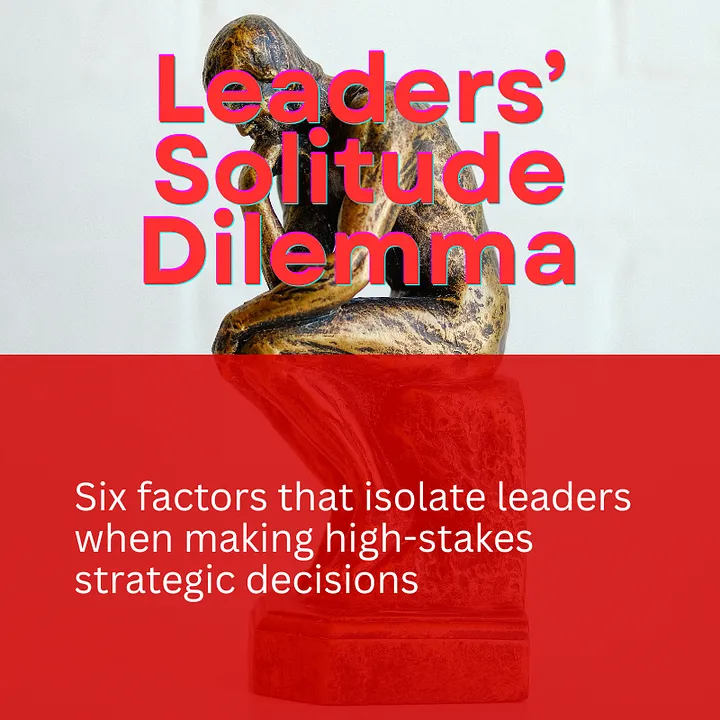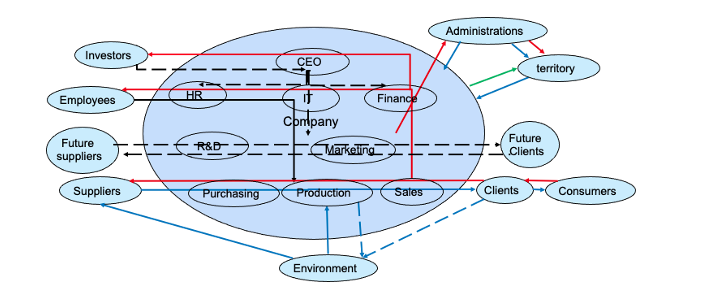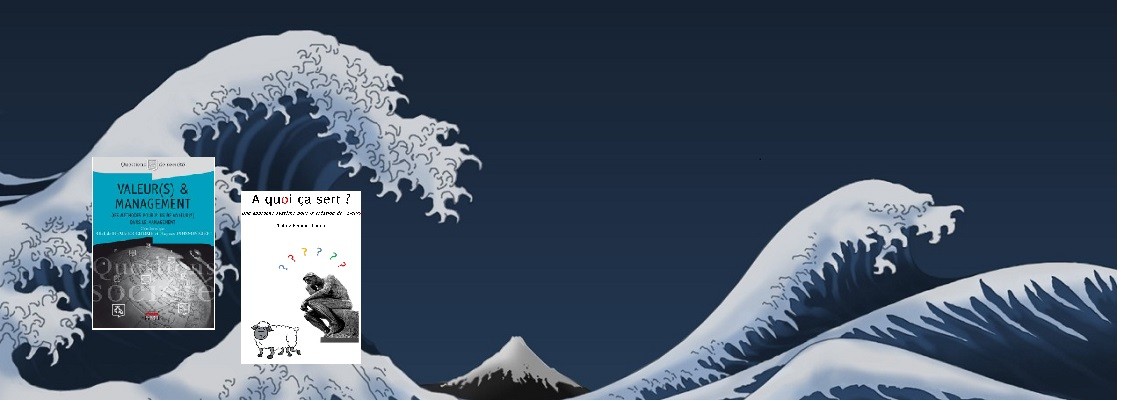
Miguel Pantaleon’s article about “leader solitude’s dilemma”[1] made me want to react.
Miguel is a passionate systems thinker “Helping Business Leaders Make Key Decisions Under Uncertainty”, with whom I engaged very interesting discussions about the limits of ‘causal loops diagrams’. My reaction: causes -even looped- cannot reveal the goals and needs which are the basis of any decision?!
This relates to another systems scientist Prof. Derek Hitchins’s article “Demystifying systems engineering”: they both miss the crucial point of ‘teleology’!
Let me explain this before coming back to our leader solitude …
Systems thinking by Jean-Louis Le Moigne
The definition of a ‘system’ by INCOSE is “A system is an arrangement of parts or elements that together exhibit behavior or meaning that the individual constituents do not.”[2]
Jean-Louis Le Moigne[3] showed us[4] how to model this behavior/meaning from the input>output flows with the external (eco)system, linked with the solution architecture at different levels, at different life cycle steps … The introduction of this book proposes “un nouveau Discours de la Méthode” (sorry, difficult to translate to English): a new paradigm aiming -not less- to frame our thinking in a totally different way compared to the ‘classical’ scientific reasoning based on the ’cartesian’ thinking proposed by René Descartes which so much helped scientists since the 17e century Enlightenment.
The 4 ‘systems’ principles by Le Moigne compared to ‘cartesian’ principles:
| The ‘cartesian’ principles: | The ‘systems’ principles: |
| > Evidence: knowledge is absolute | > Relevance: knowledge is relative |
| > Analysis: understanding the whole by its parts | > Globalism: understanding the object by its environment |
| > Causality: causes / effects relations | > Teleology: goals / means relations |
| > Completeness: make sure you do not omit any details | > Agregativity: choose an overall representation |
We find here what is so much missing in many problem-solving issues:
- People’s point of views and subjectivity have to be taken into account
- The impact of things on the natural and human environment are major issues
- Goals, purpose, objectives, meaning … are crucial for people to design solutions
- Mapping a global view secures the 3 other principles
Jean-Louis Le Moigne system modeling
These principles could be summarized as another posture in the analysis of an object:
| Descartes considers: | Le Moigne considers: |
| > What’s going on inside | > What’s going on outside |
| > Relations between components | > Relations between interactors |
| > Causes in the past: « why? » | > Goals, towards the future: « what is it for? « |
> Descartes proposes to map the interior of the object of study and the cause-effect relations between its components:

‘Causality’, internal relations and objectivity are of course very relevant to UNDERSTAND things.
> Le Moigne proposes to map the outside of the object of study -like many systems thinkers- and focus on the goals-means relations between the elements of its environment:

‘Teleology’, relations with the environment and subjectivity are more relevant to DESIGN things.
Le Moigne and its followers[5] show that flows through systems are their participation to people goals and needs: a system behavior (its ‘function’) is the transformation of what come in into what goes out. Which flow from an upstream person to a downstream person to answer their needs.
A solution manages relations or flows between two elements, distinct either in space, like the relation from an actor to a target, or in time, by transformation of Inputs into Outputs.
A goal is linked to people, so each relationship is established either directly between « stakeholders » or indirectly through relationships between physical elements that are themselves related to the stakeholders through other physical elements:

This is the basis of how Le Moigne proposes to model systems: by representing the relations of things with the elements in their environment, where flows crossing a thing from upstream to downstream are the ‘behavior / meaning’ exhibited by the system[6].
This tool gives system thinkers a way to improve modeling by not only showing ‘causal loops’ (a specificity of systems when mapped in a ‘cartesian’ way) but also showing people goals and needs, to take relevant design decisions.
Le Moigne’s 4 principles and his modeling tool are the major points of the Value(s) methods I (and so many others) use to improve solutions design and generate organizational change.
Dozens of examples are available to show how system modeling led to radical innovation in product / process / organization design.[7] How can this help him fight his solitude?
What about a company ?
Let us apply this system modeling to a company: I have built this modeling numerous times with company Executive Committees or managers and teams, in meetings for managers associations, with business school students … and always ended in less than 1 hour with the same result:

Any company is a ‘system’ in direct contact with external entities: shareholders, clients, employees, suppliers, administration, environment and society (its ‘stakeholders’).
Its ‘behavior’ is to manage and transform flows between these stakeholders: money, products and services, information, energy. Its purpose is to “create value(s) for each stakeholder, by exchanges where each ones perceives receiving it more than it gives”.
No stakeholder can be forgotten. No company can survive in the long term if one of the stakeholder is not satisfied: it will no longer exchange with the company, so other stakeholders will not receive what he gave.
A new ‘systemic’ vision of the company
This model leads to a graphical representation of Edward Freeman’s “stakeholders’ theory”[8], improving it by showing which ‘value’ each of the stakeholder is waiting for: some are waiting for money, others (clients) give it …!
It simplifies the definition of any company’s “purpose”: contributing to the wellbeing of all (?) or specific stakeholders.
It also shows that each stakeholder gives something in return of what it receives: taxes paid to the State are eventually the payment of infrastructures and services delivered to the company or the ‘society’ (every people around the company, including its clients, employees, etc. close or not).
It also shows that the ultimate source of any material and energy flowing through the company to its clients and consumers comes from … Nature, which is the ‘forgotten’ stakeholder of any company, freely giving ‘eco-services’ (air, water, light, soil, food …) and receiving … scraps and pollution … until it cannot provide clean services anymore! Therefore, the recent development of CSR to secure positive impacts on ‘environment’ and ‘society’.
It helps understand the most recent developments pleading for ‘regenerative’ companies: they have to provide each stakeholder what it needs to thrive = to be better after the exchange than before = to regenerate itself -including Nature.
This model, very simple to draw using Le Moigne’s system modelling tool, is today implemented by many company leaders, like Unilever’s ex-CEO Paul Polman[9], and Mars’s ex-Chief Economist Bruno Roche[10]. It could lead to simplification of ‘extra-financial accounting’ : the material, energy, information in- and out-flows can be traced, like money flows are today ; their impacts on stakeholders satisfaction can be evaluated, like client satisfaction is today …
What about the leaders – and the others?
If the leader can feel alone, he surely is not the only one in charge of achieving the company’s goals! But what are the roles of the other managers and actors in the company? This can be modelled with the same system modeling tool:

Each actor or function in a company is directly in charge of the exchanges and wellbeing with a specific external stakeholder of the company – clients for Sales, employees for HR, suppliers for Purchasing …- and with their internal stakeholders in the company -production for Sales and Purchasing …
Company system modeling as a tool against solitude
This ‘theoretical’ view has been used with success in many company problems: to re-align conflicting Board of Directors, to deploy corporate purpose across a company, to define corporate performance criteria, to embark all managers in a CSR project, to shape negotiations with Suppliers using all the company functions support, to decide on Make / Buy / Rent solutions for future production, to redesign organizations, to optimize products and services, to improve Purchasing, etc.
A collaborative system modeling exercise can be done by a facilitator asking professionals the following question: “What for is a company? For whom?”.
Various participants give various answers: from “for the shareholders to earn money” to “to deliver a service to the clients” … The facilitator then models the answers inf the form of flows (money, service …) going from the company to stakeholders (shareholders, clients …).
The next step is to ask: “Where does these flows come from?”
The answers are usually not spontaneous but quite easy: the money going to shareholders comes from … clients; the service going to clients comes from … employees and suppliers; …
The next step is to ask: “How come the upstream stakeholders give this to the downstream stakeholders?”. The answers come often puzzled but simple: clients give their money to … receive the service; suppliers give their resources to … receive money; … The model so develops until we get the model shown above!
This shows that no company actor or entity can achieve his role in the company without the help of the other actors: no Investor can be satisfied if Clients are not -they will not give their money long- ; no Client can be satisfied if Suppliers are not -they will not provide the quality inputs- … So Purchasing has to satisfy Suppliers so that Production makes the right products for Sales and Clients … Everybody inside AND outside the company is mutually interdependent! We are not alone …
Realizing this is a major shift in the understanding of a company for many -not only the leaders! Of course power games and competition still exist … inside and outside the company, but this exercise results in seeing that a company is not a zero-sum game : I win only IF they all win (in the long term) !
I used this modeling tool for each company project I coached for 25 years, often leading to radical innovations, with more desirable / responsible, viable / sober and feasible / cooperative solutions.
For examples of concerte projects which led to responsaible * sober * cooperative solutions, read the newsletter « Que suffit-il ? » (sorry, in French, but you can ask Google to translate it 😉
[1] https://medium.com/@MiguelPantaleon/leaders-solitude-dilemma-377369d2482f
[2] « Systems engineering and Systems definitions” INCOSE, 8/01/2019 chrome-extension://efaidnbmnnnibpcajpcglclefindmkaj/https://www.incose.org/docs/default-source/default-document-library/incose-se-definitions-tp-2020-002-06.pdf?sfvrsn=b1049bc6_0
[3] French specialist of systems thinking and engineering, https://en.wikipedia.org/wiki/Jean-Louis_Le_Moigne
[4] « Théorie du système général : théorie de la modélisation » Ed° PUF 1977, available online https://archive.org/details/JL.LeMoigne_theorie-du-sys-general_theorie_modelisation_1977
[5] Systems engineers, Value(s) methods experts and many others
[6] see INCOSE definition of systems above
[7] “What is it for? A systems approach for value(s) creation” Olaf de Hemmer Gudme, Ed° Createspace 2018, and “What is enough?” (in progress)
[8] https://en.wikipedia.org/wiki/Stakeholder_theory
[9] « Net Positive : how courageous companies thrive by giving more than they take” Paul Polman, Andrew S. Winston, Harvard Business Review Press 2021
[10] « Economics of mutuality alliance » with Mars and Oxford’s Saïd Business School https://eom.org/
